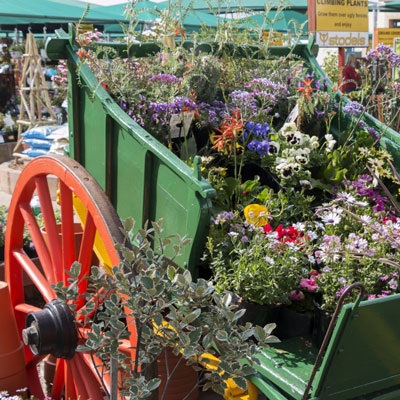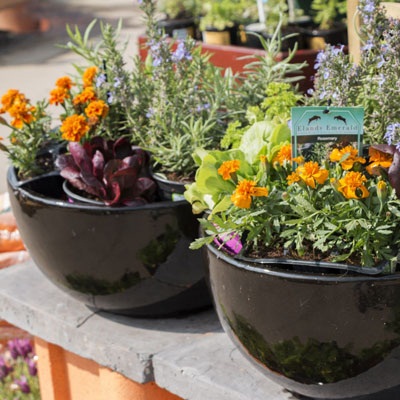Containers are increasingly being used for gardening on balconies or indoors as they are so versatile. Knee-high containers are easier to maintain without bending or kneeling.
Containers of various heights may be used to add height to a border or certain areas in the garden. An attractive container, even without plants, can be used as a focal point, or you can plant herbs to make a different, edible container garden feature.
Many gardens in the Cape have an alkaline soil, but plants which prefer acid in soil can be planted in containers by simply adding the correct soil type.
Which one is best?
- When choosing containers, remember that concrete containers are much stronger than many plastic types, but may be too heavy to move around freely when filled with soil, so position heavy containers where you want them before filling and planting. Plastic containers may become brittle and crack after time in very warm, dry areas.
- Unglazed clay containers need to be watered more often in dry areas as water evaporates through the porous structure of the pot. You can line them with a plastic liner but when not lined, make sure that the outside of the clay pot is also watered every time the plants are irrigated.
- It’s best to invest in deep pots for summer planting as shallower types tend to dry out very quickly.
You will need the following when potting up a container:
- Your choice of container
- River sand to stop water from just running through your pot
- Bone meal to stimulate root growth
- Potting soil and drainage chips
- Aquasoil or Stockosorb
- Nitrosol
- Decorative stones
- Pot and tray
How to plant in containers
- Ensure that there are enough drainage holes at the base of the container.
- Cover the bottom of the container with a layer of small pebbles. The larger the container, the thicker the layer of pebbles should be.
- Add a layer of wet river sand which will act as a filter and keep the nutrients around the root of the plant.
- Then cover with a layer of moist compost.
- The planting hole should be 16cm wider than the diameter of the root area of the plant.
- Gently remove the plant from the old container.
- Where the roots are matted, gently loosen the damp roots with your fingertips.
- Roots that are unnecessarily long should be cut shorter.
- Pour a little water into the hole where the plant will be positioned.
- Spread the roots out evenly to avoid bending them when placing the plant in the hole.
- Add 60mg (a handful of bone meal to the mix).
- Cover the roots with soil.
- Add a sprinkling of Aquasoil or Stockosorb or which will assist with evaporation.
- Firm down the soil around the transplanted plant and water well.
Creating colourful containers:
- When planning to have a number of pots together, consider the entire setting.
- Choose plants that will complement each other, the setting and the containers that they are in.
- Make use of the wide range of colours, textures, foliage and scents.
- Add Aquasoil or Stockosorb to your potting soil and keep your pots well watered – daily watering will probably be necessary in the heat of summer. Do not forget a tray if you are concerned about water stains.
- Feeding is essential as the roots are restricted to the confines of the pot.
- Use liquid fertiliser, Nitrosol, once a fortnight for best results.
- Make use of pebbles, statues, wood, etc. to add to the effect.

Great choices for Small Gardens:
- Yesterday, today and tomorrow plants (Brunfelsia spp.) grow well in full sun or partial shade. It is semi hardy and grows well in containers. It produces masses of white, lilac and purple flowers and it has a wonderfully sweet smell.
- Azaleas are a great container plant for semi-shady areas. They flower in spring, but have an attractive evergreen foliage all year round.
- The indigenous African daisy (Arctotis) grows well in pots, rockeries and garden banks. It grows best in full sun and will tolerate strong winds and very cold conditions. It is available in a range of bright colours.
- Climbing plants are a great choice for small gardens as they create the illusion of space by drawing the eye upwards. Try bougainvillea, black-eyed Susan, climbing roses, clematis and sweet peas.
- Most herbs grow very well in pots. Plant them outside your kitchen door or in a window box at the kitchen window. Also try planting herbs in a pot close to your braai area – then they’re on hand for making marinades. Rosemary twigs can also be used as skewers for kebabs or a bunch is a natural basting brush.
- If you’re looking for colourful flowers than will thrive in pots in sunny areas, try filling them with the following summer blooms: floribunda roses, petunias, gazanias, portulaca, geraniums, dianthus, pelargoniums and marigolds. For best results, feed plants in pots with a liquid foliar feed – such as Nitrosol once a month.

All images: supplied
Planting in small gardens or on balconies can be very rewarding – with the right plants and pots, you can turn even the smallest outdoor area into your own piece of Eden.
For more information, like Stodels on Facebook or visit their website.
Follow Women24 on Twitter and like us on Facebook.
Containers of various heights may be used to add height to a border or certain areas in the garden. An attractive container, even without plants, can be used as a focal point, or you can plant herbs to make a different, edible container garden feature.
Many gardens in the Cape have an alkaline soil, but plants which prefer acid in soil can be planted in containers by simply adding the correct soil type.
Which one is best?
- When choosing containers, remember that concrete containers are much stronger than many plastic types, but may be too heavy to move around freely when filled with soil, so position heavy containers where you want them before filling and planting. Plastic containers may become brittle and crack after time in very warm, dry areas.
- Unglazed clay containers need to be watered more often in dry areas as water evaporates through the porous structure of the pot. You can line them with a plastic liner but when not lined, make sure that the outside of the clay pot is also watered every time the plants are irrigated.
- It’s best to invest in deep pots for summer planting as shallower types tend to dry out very quickly.
You will need the following when potting up a container:
- Your choice of container
- River sand to stop water from just running through your pot
- Bone meal to stimulate root growth
- Potting soil and drainage chips
- Aquasoil or Stockosorb
- Nitrosol
- Decorative stones
- Pot and tray
How to plant in containers
- Ensure that there are enough drainage holes at the base of the container.
- Cover the bottom of the container with a layer of small pebbles. The larger the container, the thicker the layer of pebbles should be.
- Add a layer of wet river sand which will act as a filter and keep the nutrients around the root of the plant.
- Then cover with a layer of moist compost.
- The planting hole should be 16cm wider than the diameter of the root area of the plant.
- Gently remove the plant from the old container.
- Where the roots are matted, gently loosen the damp roots with your fingertips.
- Roots that are unnecessarily long should be cut shorter.
- Pour a little water into the hole where the plant will be positioned.
- Spread the roots out evenly to avoid bending them when placing the plant in the hole.
- Add 60mg (a handful of bone meal to the mix).
- Cover the roots with soil.
- Add a sprinkling of Aquasoil or Stockosorb or which will assist with evaporation.
- Firm down the soil around the transplanted plant and water well.
Creating colourful containers:
- When planning to have a number of pots together, consider the entire setting.
- Choose plants that will complement each other, the setting and the containers that they are in.
- Make use of the wide range of colours, textures, foliage and scents.
- Add Aquasoil or Stockosorb to your potting soil and keep your pots well watered – daily watering will probably be necessary in the heat of summer. Do not forget a tray if you are concerned about water stains.
- Feeding is essential as the roots are restricted to the confines of the pot.
- Use liquid fertiliser, Nitrosol, once a fortnight for best results.
- Make use of pebbles, statues, wood, etc. to add to the effect.

Great choices for Small Gardens:
- Yesterday, today and tomorrow plants (Brunfelsia spp.) grow well in full sun or partial shade. It is semi hardy and grows well in containers. It produces masses of white, lilac and purple flowers and it has a wonderfully sweet smell.
- Azaleas are a great container plant for semi-shady areas. They flower in spring, but have an attractive evergreen foliage all year round.
- The indigenous African daisy (Arctotis) grows well in pots, rockeries and garden banks. It grows best in full sun and will tolerate strong winds and very cold conditions. It is available in a range of bright colours.
- Climbing plants are a great choice for small gardens as they create the illusion of space by drawing the eye upwards. Try bougainvillea, black-eyed Susan, climbing roses, clematis and sweet peas.
- Most herbs grow very well in pots. Plant them outside your kitchen door or in a window box at the kitchen window. Also try planting herbs in a pot close to your braai area – then they’re on hand for making marinades. Rosemary twigs can also be used as skewers for kebabs or a bunch is a natural basting brush.
- If you’re looking for colourful flowers than will thrive in pots in sunny areas, try filling them with the following summer blooms: floribunda roses, petunias, gazanias, portulaca, geraniums, dianthus, pelargoniums and marigolds. For best results, feed plants in pots with a liquid foliar feed – such as Nitrosol once a month.

All images: supplied
Planting in small gardens or on balconies can be very rewarding – with the right plants and pots, you can turn even the smallest outdoor area into your own piece of Eden.
For more information, like Stodels on Facebook or visit their website.
Follow Women24 on Twitter and like us on Facebook.




 Publications
Publications
 Partners
Partners













